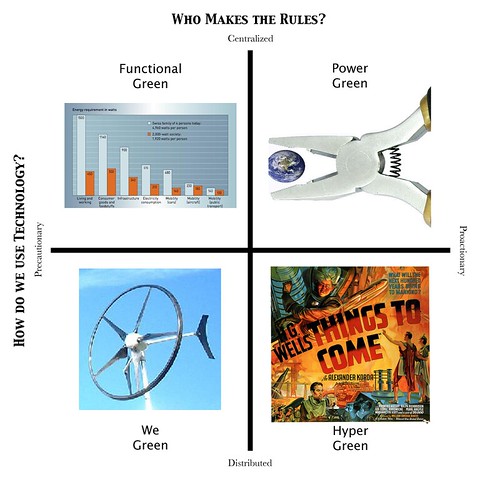Green Tomorrows: Four Scenarios
Posted by Big Gav in future, global warming, greenland, scenario modelling
Jamais Cascio at Open The Future has an interesting look at 4 green future scenarios (with one of his customary nifty graphics from his Flickr account) - looking at a set of options similar to the usual 2/2 political map and considering what the green version of each of the quadrants would look like.
... The Drivers
The two critical uncertainties used as scenario axes aren't meant to cover every possible force driving change; rather, they're what I've come to see as issues that are fundamental to how the next few decades play out. ...
The first driver is Who Makes the Rules?, with end-points of Centralized and Distributed. This driver looks at the locus of authority regarding the subject (in this case, climate responses) -- are outcomes dependent upon choices made by top-down, centralized leadership, or made by uncoordinated, distributed decision-making? ...
Although my bias tends towards distributed/collaborative, top-down models are often better-able to respond quickly to rapid developments, and can also offer a more predictable environment for business and organizational planning.
The second driver is How Do We Use Technology?, with end-points of Precautionary and Proactionary. ...
My bias here is towards a limited precautionary approach, but the need for rapid response may end up pushing towards a proactionary world.
The Scenarios
The combination of these two drivers give us four distinct worlds.
"Power Green" -- Centralized and Proactionary: a world where government and corporate entities tend to exert most authority, and where new technologies, systems and response models tend to be tried first and evaluated afterwards. This world is most conducive to geoengineering, but is also one in which we might see environmental militarization (i.e., the use of military power to enforce global environmental regulations) and aggressive government environmental controls. "Green Fascism" is one form of this scenario; "Geoengineering 101" from my Earth Day Essay is another.
"Functional Green" -- Centralized and Precautionary: a world in which top-down efforts emphasize regulation and mandates, while the deployment of new technologies emphasizes improving our capacities to limit disastrous results. Energy efficiency dominates here, along with economic and social innovations like tradable emissions quotas and re-imagined urban designs. The future as envisioned by Shellenberger and Nordhaus could be one form of this scenario; the future as envisioned by folks like Bill McDonough or Amory Lovins could be another. Arguably, this is the default scenario for Europe and Japan.
"We Green" -- Distributed and Precautionary: a world in which collaboration and bottom-up efforts prove decisive, and technological deployments emphasize strengthening local communities, enhancing communication, and improving transparency. This is a world of micro-models and open source platforms, "Earth Witness" environmental sousveillance and locavorous diets. Rainwater capture, energy networks, and carbon labeling all show up here. This world (along with a few elements from the "Functional Green" scenario) is the baseline "bright green" future.
"Hyper Green" -- Distributed and Proactionary: a world in which things get weird. Distributed decisions and ad-hoc collaboration dominate, largely in the development and deployment of potentially transformative technologies and models. This world embraces experimentation and iterated design, albeit not universally; this scenario is likely to include communities and nations that see themselves as disenfranchised and angry. Micro-models and open source platforms thrive here, too, but are as likely to be micro-ecosystem engineering and open source nanotechnology as micro-finance and open source architecture. States and large corporations aren't gone, but find it increasingly hard to keep up. One form of this scenario would end with an open source guerilla movement getting its hands on a knowledge-enabled weapon of mass destruction; another form of this scenario is the "Teaching the World to Sing" story from my Earth Day Essay.
The Choice
Which scenario is most likely? It depends a bit on how fast the truly disastrous manifestations of climate change hit. Climate catastrophe happening earlier than currently projected would push towards the more proactionary worlds. It also depends a bit on whether governments and corporate leaders continue to lag community and activist groups in terms of willingness to embrace big changes to fight environmental risks. Centralized responses may end up being too little, too late if wide-spread bottom-up models take root.
Ultimately, which one of these scenarios comes to dominate depends on the choices we make today. We simply can't go on pretending that we don't have to deal with this problem for awhile yet, that "the market" or "the government" or "new technologies" will fix everything in time, that we aren't responsible. The more we abandon our responsibilities, our agency, the more likely it is that the world that emerges will not pay attention to our interests. Acting now is no guarantee that we'll get the world we want -- but not acting is as close as you'll get to a guarantee that we won't.






